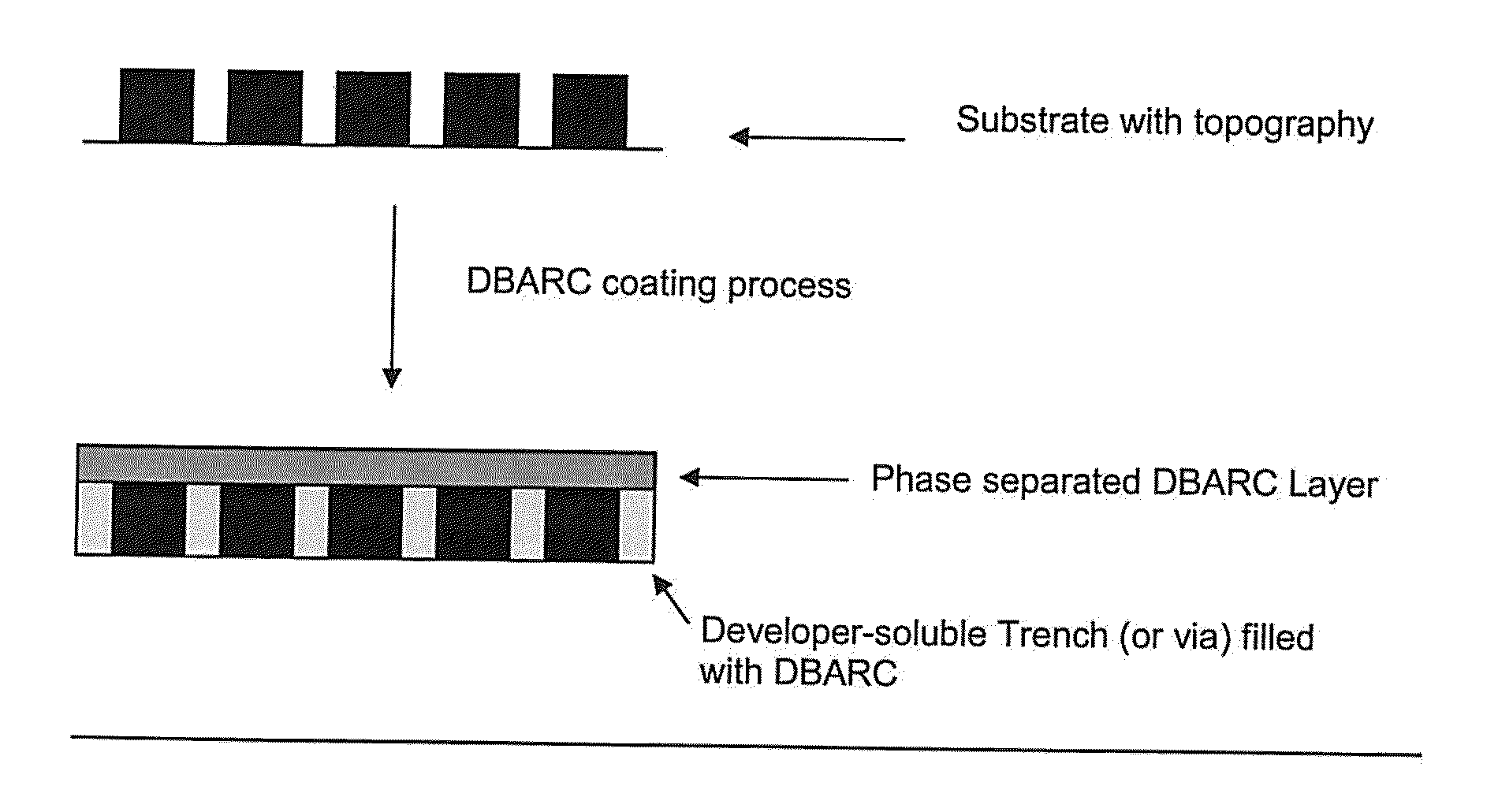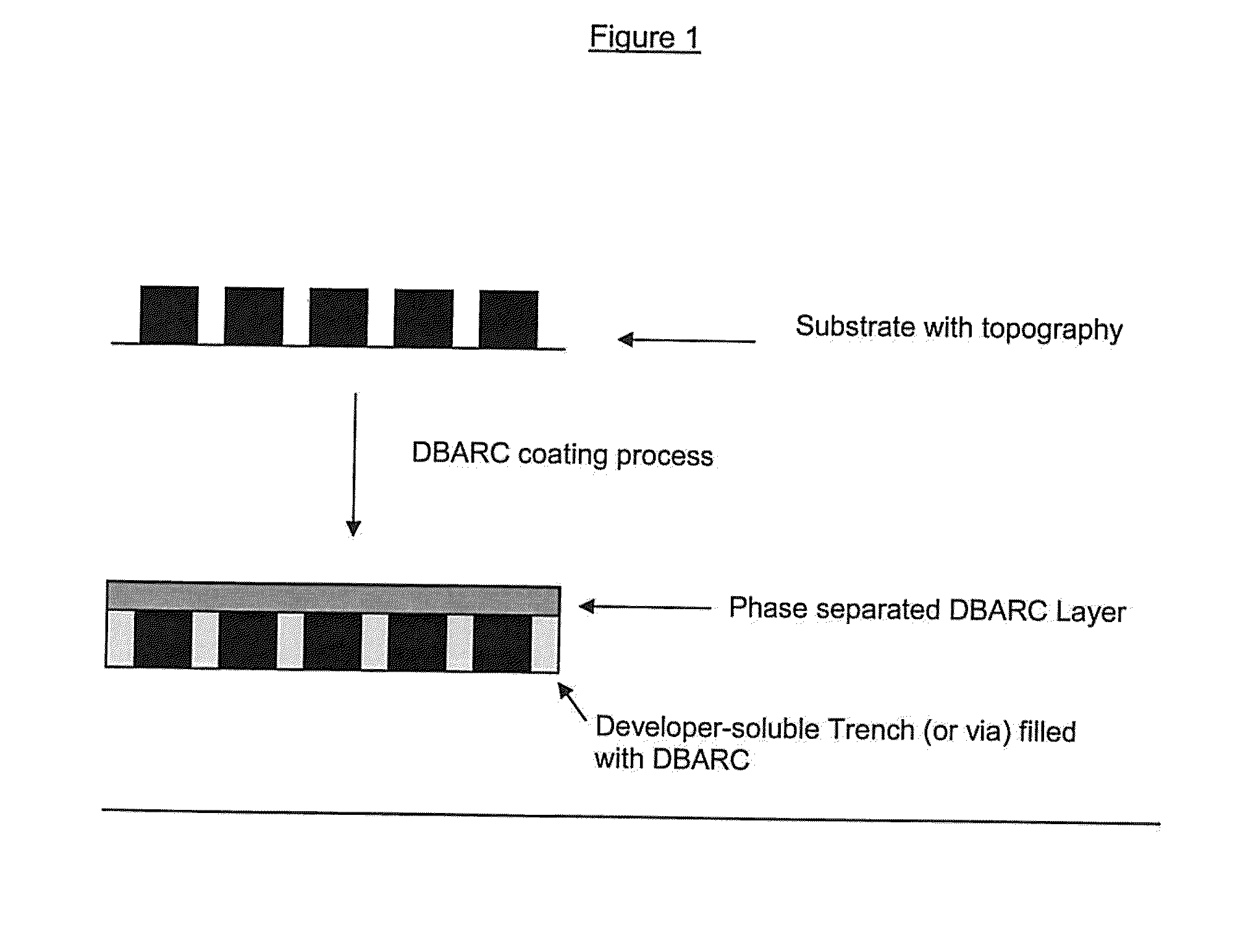Positive-Working Photoimageable Bottom Antireflective Coating
a technology of anti-reflective coating and positive working, which is applied in the direction of photosensitive materials, photomechanical equipment, instruments, etc., can solve the problems of damage to the substrate, inability to precisely transfer the photoresist pattern to the substrate,
- Summary
- Abstract
- Description
- Claims
- Application Information
AI Technical Summary
Benefits of technology
Problems solved by technology
Method used
Image
Examples
example 1
Synthesis of (PQMA / AMMA / MA-BTHB-OH) terpolymer
[0046]
[0047]In a 250 mL round bottom flask equipped with a stirrer, thermocouple and reflux condenser under nitrogen, 9-anthracenylmethyl methacrylate (AMMA, 4.34 g), 4-hydroxyphenyl methacrylate (PQMA, 8.410 g), 1-hydroxy-1,1-bis(trifluoromethyl)-3-butyl methacrylate (MA-BTHB-OH, 4.87 g), 2,2′-azobis(2-methylpropionitrile) (AIBN, 0.86 g), and tetrahydrofuran (THF, 106.50 g) were added and stirred to dissolve the solids. The mixture was heated to 65° C. for 5 hours, cooled for 30 minutes to room temperature, then precipitated into hexanes (800 mL). The precipitate was collected by vacuum filtration, dissolved in tetrehyrofuran (THF) (90 mL), and precipitated in hexanes (800 mL) once, again. The precipitate was collected by vacuum filtration and dried at 45° C. to yield a white solid (14.4 g, 79%). Polymer molecular weight and NMR composition are provided in Table 1.
The polymer had n&k values at 248 nm of 1.56 & 0.33 and 1.76 & 0.46 at 19...
example 2
Synthesis of PQMA / EAdMA / PFPMA terpolymer
[0048]In a 250 mL round bottom flask equipped with a stirrer, thermocouple and reflux condenser under nitrogen, 2-ethyladamantylmethacrylate (EAdMA, 7.75 g), 4-hydroxyphenyl methacrylate (PQMA, 16.69 g), 2,2,3,3,3-pentafluoropropylmethacrylate (PFPMA, 6.81 g), 2,2′-azobis(2-methylpropionitrile) (AIBN, 6.25 g), and tetrahydrofuran (THF, 87.50 g) were added and stirred to dissolve. The mixture was heated to 65° C. for 5 hours, cooled for 30 minutes to room temperature, then precipitated into hexanes (875 mL). The precipitate was collected by vacuum filtration, dissolved in THF (85 mL), and precipitated in hexanes (875 mL) once again. Finally, the precipitate was redissolved in 80 mL of methanol and precipitated in water (875 mL). The precipitate was collected by vacuum filtration and dried at 45° C. to yield a white solid (23.14 g, 74%). Polymer molecular weight and NMR composition are provided in Table 1.
The polymer had n&k values at 193 nm of ...
example 3
PQMA / PFPMA / MA-3,5-HFA-CHOH terpolymer
[0049]In a 250 mL round bottom flask equipped with a stirrer, thermocouple and reflux condenser under nitrogen, 3,5-bis(hexafluoro-2-hydroxy-2-propyl)cyclohexyl methacrylate (MA-3,5-HFA-CHOH, 8.28 g), 4-hydroxyphenyl methacrylate (PQMA, 11.78 g), 2,2,3,3,3-pentafluoropropylmethacrylate (PFPMA, 6.02 g), 2,2′-azobis(2-methylpropionitrile) (AIBN, 3.91 g), and tetrahydrofuran (THF, 70.00 g) were added and stirred to dissolve. The mixture was heated to 65° C. for 5 hours, cooled for 15 minutes, quenched with methanol (3 mL), further cooled to room temperature, and then precipitated into hexanes (750 mL). The precipitate was collected by vacuum filtration, dissolved in THF (85 mL), and precipitated in hexanes (750 mL) once again. Finally, the precipitate was redissolved in 70 g of methanol and precipitated in water (750 mL). The precipitate was collected by vacuum filtration and dried at 45° C. to yield a white solid (22.19 g, 85%). The n & k values of...
PUM
 Login to View More
Login to View More Abstract
Description
Claims
Application Information
 Login to View More
Login to View More - R&D Engineer
- R&D Manager
- IP Professional
- Industry Leading Data Capabilities
- Powerful AI technology
- Patent DNA Extraction
Browse by: Latest US Patents, China's latest patents, Technical Efficacy Thesaurus, Application Domain, Technology Topic, Popular Technical Reports.
© 2024 PatSnap. All rights reserved.Legal|Privacy policy|Modern Slavery Act Transparency Statement|Sitemap|About US| Contact US: help@patsnap.com










